
ISSN: 2321 9653; IC Value: 45.98; SJ Impact Factor: 7.538

Volume 10 Issue X Oct 2022 Available at www.ijraset.com


ISSN: 2321 9653; IC Value: 45.98; SJ Impact Factor: 7.538

Volume 10 Issue X Oct 2022 Available at www.ijraset.com
Gagan Sharma1, Harivansh Kumar Chaudhary2, Akash Malik3
1PG Student, Department of Civil Engineering, Galgotias University, Greater Noida (UP) 2,3Assistant Professor, Department of Civil Engineering, Galgotias University, Greater Noida (UP)
Abstract: Eco-friendly wastes are being used to make green concrete. It minimizes Carbon footprints while causing the lowest environmental damage. It saves up to 20percent of total on water demand. The down on carbon footprints by 40-50 percent throughout the manufacturing process, the increase in construction activity in underdeveloped nations, and the use of lesser water are the principal factors boosting the green concrete market. Still though, it provides a significant degree of fireproofing and good thermal insulation, allowing green concrete to be used in structures. Green asphalt can be made from a variety of plastic waste. The use of waste materials and admixtures to partially replace substances results in increased compressive strength and split tensile, corrosion conductivity, porosity reduction, and improved flowability.
Keywords: Fly ash, green concrete, Asphalt, Permeability, Compressive strength, Tensile Strength.
Green concrete, which was initially invented in Denmark in 1998, is one of the groundbreaking subjects in the cement industry in terms evolution. Around the world, the construction sector is increasing at a rapid rate. Because waste products are often used as a partial substitute for cement, green concrete is less expensive to manufacture, with fewer disposal costs, reduced energy usage, and improved durability. Debris can be used to develop new products or as admixtures in other products, enabling for even more effective use of natural resources while also protecting the environment from waste deposits. Instead of using a 100 percent Portland cement mixture, 25 percent to 100 percent fly ash is utilized for making green materials. Decrease the amount of CO2 released into the atmosphere. In the cement manufacturing, the consumption of fossil fuels was reduced by increasing the use of waste derived fuels. During their service lives, the structures do not cause significant environmental damage. The tensile strength of recycled aggregate concrete was improved by replacing half of the cement with slag. Green concrete's key goals are cheap material and energy costs, no pollution, and sensible development. The green concrete was quickly made and put. Green masonry is a variety of mortar that's also made from either an array of substances. from concrete waste or by products industries. When compared to traditional concrete, it uses less energy. The content Coarse aggregates, fine aggregates, fly ash, and water are all used in green concrete. Applications Green concrete is used in the construction of bridges, roadways, columns, and other structures. The price of When compared to traditional concrete, the cost of building or materials is lower with green concrete. Green concrete differs from ordinary concrete in that the substance used in its production is disposable local fresh aggregates, recycled concrete, river sand, recycled glass aggregates, fly ash, and water
Green concrete is a game changing concept in the concrete manufacturing industry's history. In the year 1998, it was initially invented in Denmark. Green concrete is manufactured from concrete scraps or other industrial waste. It uses less energy to manufacture and emits less carbon dioxide. Green concrete is an environmentally friendly concrete that causes less harm to the environment. Carbon dioxide emissions in the industry have been reduced by 30%. When compared to traditional concrete, the cost of building is inexpensive.
The most important component of concrete is cement, which is made out of limestone (calcium carbonate). Cement materials are heated to around 800 1000°C throughout the manufacturing process. Carbon dioxide is released during the cement making process. Approximately 1kg of cement is produced from 900grms of carbon dioxide, and green concrete was created to reduce carbon dioxide emissions.
ISSN: 2321 9653; IC Value: 45.98; SJ Impact Factor: 7.538

Volume 10 Issue X Oct 2022 Available at www.ijraset.com
1) Fly dust.
2) Aggregate of Glass.
3) Sand that has been manufactured.
4) Aggregate from Recycled Concrete.
5) Aggregate from Recycled Demolition Waste.
6) Slag from a blast furnace (BFS).
Fly dust Description Fly dust is a waste petroleum power stations generate this chemical. Electrostatic precipitators capture the finely divided particles from the exhaust gases. Fly ash is the name given to these particles. Fly dust is the most widely utilized pozzolanic material on the planet. Fly ash is produced at a rate of roughly 75 million tons per year, and its disposal has become a major challenge. Only about 5% of total fly ash is used in India, with the remainder having to be disposed of. For every tons of PC produced, around 1.5 tons of raw materials are required, and approximately one tons of CO2 is discharged into the atmosphere.
D. Fly ash in Green Concrete has a Number of Technical Advantages
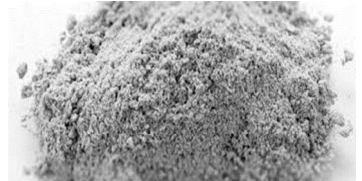
1) Increasing ultimate strength.
2) Durability has improved.
3) Enhanced workability
4) Reduced bleed.
5) Reduced shrinking.
a) Aggregate of Glass Glass resembles natural sand when broken and screened to pass through a 5 mm sieve, and it has technical attributes similar to other fine aggregate materials. As a result, waste glass aggregate (WGA) is taken into account as a feedstock alternative for construction aggregates. The addition of glass aggregates improved the surface resistivity and sulphate attack resistance of glass cement based materials, and the improvement increased with the amount of sand replaced. This glass residue also used in green concrete.
Figure III
Aggregate of glass

ISSN: 2321 9653; IC Value: 45.98; SJ Impact Factor: 7.538 Volume 10 Issue X Oct 2022 Available at www.ijraset.com

b) Sand That has been Manufactured For concrete building, manufactured sand (M Sand) is a substitute for river sand. Crushed hard granite stone is used to make manufactured sand. Crushed sand is cubical in shape with grounded edges, rinsed, and graded for use as a building material. Moisture is trapped between the particles, which is beneficial to concrete. When compared to river sand, this concrete has a higher strength. The maximum amount of silt that can be present is 3%. Despite the fact that M Sand is made from natural coarse aggregates, it is less harmful to the environment than river sand.
Figure IIIII
Sand that has been manufactured
c) Aggregate from Recycled Concrete Concrete material that has been crushed is referred to as recycled concrete material. It's similar to demolition debris. Demolition of existing building slabs, concrete pavement, and bridge constructions from private facilities are all sources of recycled concrete resources. The materials are crushed into bits and then reassembled into coarse aggregates. Similar to demolition trash, such aggregates are utilized in the preparation of concrete mix designs or the construction of concrete roadways.
Figure IVV
Aggregate from recycled concrete
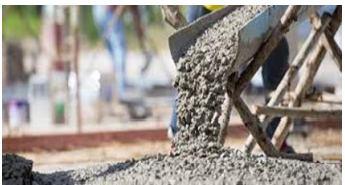
d) Aggregate from Recycled Demolition Waste The use of building and demolition waste aggregates aids in the reduction of natural aggregate depletion and challenges associated with aggregate mining. Natural aggregates have been shown to be of higher quality than building and demolition waste aggregates. As a result, demolition waste aggregates have a limited application. However, the lower cost of producing concrete with the use of building and demolition waste aggregates must be recognized. With the help of recovered construction demolition debris, the life cycle of construction materials can be extended. This has resulted in a 90 percent increase in the amount of building and demolition waste material that may be recycled.
Figure V
Aggregate from Recycled Demolition Waste
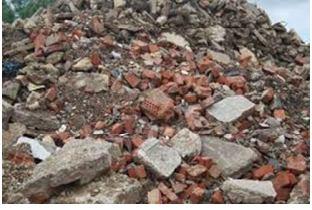
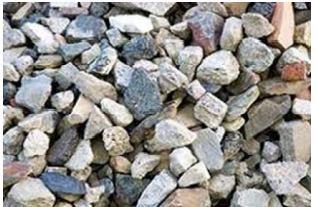
ISSN: 2321 9653; IC Value: 45.98; SJ Impact Factor: 7.538 Volume 10 Issue X Oct 2022 Available at www.ijraset.com

e) Slag from a Blast Furnace (BFS) Slag cement is a hydraulic cement that is made by grinding granulated blast furnace slag (GGBFS) to a fine powder and replacing a portion of Portland cement. It's a reclaimed iron blast furnace industrial by product. Blast furnace slag has been pelletized and used as a lightweight aggregate and in cement production. For Portland cement concrete, foamed slag has been used as a lightweight aggregate. Granulated blast furnace slag has been utilised as a cement raw material, as well as an aggregate and an insulating substance. Ground granulated slag is frequently used in concrete as part of a blended cement mix with Portland cement. Cementitious characteristics are produced when ground granulated slag combines with a calcium by product formed during the Portland cement reaction.
Figure VI
Slag from a blast furnace (BFS)
Table I
Material Use As A Green Concrete In Rigid Pavement
Waste ready mix concrete, waste glass, recycled aggregates with crushed glass, and recycled aggregates with silica fume are all examples of recycled aggregates.
Artificial sand, waste glass, fly ash and micro silica, bottom ash of municipal solid waste, fine recycled aggregate, destroyed brick waste, quarry dust, waste glass powder, marble sludge powder, rock dust and pebbles, artificial sand, waste glass, fly ash and micro silica
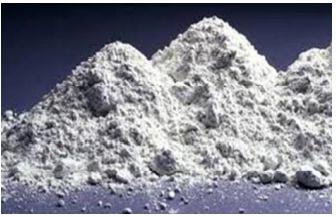
Slurry ash, municipal solid waste fly dust, environmentalist
The technique for mixing green concrete is the same as for conventional or traditional concrete. Concrete's component materials are depicted in the diagram below. They take up the smallest amount of space and leave the fewest voids in the concrete. The voids are substantial in all of the distinct concrete components. All of the spaces in dense green concrete must be filled with smaller particles.
F. Designing a green concrete mix has the following goals:
1) Optimize particle compositions and material packing to reduce vacuum space between aggregates.
2) The aggregates replace the extra cement paste, resulting in improved workability, stability, shrinkage reduction, and increased durability and strength.
3) Reduced cement will be used, resulting in less hydration heat.
G. Future Application of Green Concrete.
1) Bridge construction.
2) building construction.
3) column construction.
4) road construction.
ISSN: 2321 9653; IC Value: 45.98; SJ Impact Factor: 7.538

Volume 10 Issue X Oct 2022 Available at www.ijraset.com
1) Vinita Vishwakarma et al (2017) Agriculture, industry, bio garbage, marine debris, and e waste have all been investigated to see whether they can be recycled and used as a green concrete supplemental material. Waste materials can be used as a partial replacement for cement, lowering energy consumption during the manufacturing process. The author also investigated waste materials such rice husk ash (RHA), sawdust ash (SDA), and rubber crump. Plastic garbage, coconut husk and shell, and textile waste (sludge and fibre) are just a few of the materials that can be recycled. These wastes can be recycled and used as a component in the construction of Green Concrete structures. As a result, costs will be reduced. Reduce the amount of cement that is utilised, as well as CO2 emissions and global warming. Because they emit less CO2 and meet all of the requirements for "Green Concrete," concrete structures constructed from waste materials have a lower environmental effect. Scrap dealers should be taught and trained to sort various types of rubbish for use in the construction industry in order to give these low cost and environmentally friendly building materials.
2) K.M.Liew et al (2017) According to study, green concrete has a number of environmental, technical, and economic advantages, including greater strength, durability, improved workability and pumpability, reduced permeability, controlled bleeding, superior acid resistance, and reduced plastic shrinkage cracking. They also looked into green concrete, which includes high volume fly ash concrete, ultrahigh performance concrete, geopolymer concrete, and lightweight concrete, to name a few. Green concrete, on the other hand, has a number of benefits, including improved concrete properties, a lower carbon footprint, and natural resource conservation. In large scale infrastructure projects all around the world, green concrete should be employed. Green concrete is in high demand in the construction business due to increased regulations to reduce carbon footprint, greenhouse gas emissions, and landfill space.
3) Roushan Kumar et al (2017) have examined it is a notion of thinking about the atmosphere when it comes to concrete, taking into account everything from raw materials manufacturing to mixture design to structural design, construction, and service life. In the year 1998, this was the first time it was used. COLOR HAS NOTHING TO DO WITH THE COLOR OF GREEN CONCRETE. Because waste products, for example, are used as a partial substitute for cement, green concrete is frequently produced and is also inexpensive. By substituting waste materials and goods for standard concrete ingredients, it is possible to make concrete that is both cost effective and environmentally benign. Compressive and tensile strength are enhanced, sulphate resistance is improved, permeability is reduced, and workability is improved when waste materials and admixtures are used to partially replace constituents.
4) Nurdeen M. Altwair et al (2011) examined the modulus performance of green engineered cement composites (ECCs) containing a significant portion of oil palm shell (POFA). In able to track structural capacity, the author looked at some previous research. The four point bending test was used to cure the concrete. The results of the experiment show that the flexural After 3, 28, and 90 days, the participants' performance was assessed there appeared to be a connection between the two, according to the findings. equivalent reduction in the ECC beam' initial cracking flexural and compressive (POFAs). Flexural deflection capacity tends to increase when the water binder ratio and the POFA cement ratio rise. At water binder ratios of .33, .36, and .38, respectively, the initial cracking strength declined from 7.7 to 5.3, 6.7 to 4.9, respectively 6.4 to 4.5 MPa after 28 days, while the POFA/C improved from 0.4 to 1.2.
5) Bambang Suhendro et al (2014) Cement manufacture accounts for 8 to 10% of global CO2 emissions, according to research. Green concrete is described as concrete that contains at least one component made from waste, or whose manufacturing method does not harm the environment, or which has excellent performance and life cycle sustainability. Various initiatives have been devoted by academics to come up with such solutions that can greatly lower the quantity of electricity used and the environmental impact of the production of cement. Techniques towards manufacturing greener concrete, such as replacing a substantial proportion of cement with fly ash. In Indonesian, several people have attempted to adopt the concept of green concrete and the development of nano sio2 substances.
ISSN: 2321 9653; IC Value: 45.98; SJ Impact Factor: 7.538 Volume 10 Issue X Oct 2022 Available at www.ijraset.com

6) Janez Turk and colleagues (2015) Green mix design were created using three different types of manufacturing by products, namely (1) foundry dust and (2) blast furnace slag, all of which were thoroughly investigated. (3) Fly dust, was used as a mineral in the past., was used as a produced aggregate. admixture. A recycled aggregate was also used to make some green concrete mixtures obtained from the leftovers of reinforced concrete A circular economy might be developed in this fashion, closing the material loops while also minimising the quantity of garbage that needs to be landfilled. But since concrete has been the most widely used building material on the planet (Gursel et al., 2014; Marie and Quiasrawi, 2012; Van den Heede and De Belie, 2012), commodity concept of sustainable development is critical inside the concrete manufacturing base. The findings of the alternative scenarios, on the other hand, were shown to be rather unaffected by the delivery distances of the alternative materials.
Cement, coarse aggregates, sand, and water, all of which are expensive, are utilised in traditional concrete. The cement is utilised in the concrete mixing process. generating the heat generated by hydration The cement is utilised as a binding agent in the construction. reasons of construction Cement making emits carbon dioxide, which is harmful to the environment. impact on the environment as a result, numerous strategies are being used to reduce carbon dioxide emissions. which are more expansive, are employed. Green concrete has been adopted to minimise costs and carbon dioxide emissions. Because the green concrete components are locally and regionally available, such as local aggregates, concrete waste, recycled aggregates, fly ash, recycled glass aggregates, and industry waste. Because it is manufactured from concrete waste, green concrete materials are less expansive. When compared to traditional concrete, the cost of construction, maintenance, and repair will be lower. CO2 is a greenhouse gas produced by green concrete is lower than that produced by ordinary concrete.
When compared to traditional concrete, green concrete is a more environmentally friendly option. It is preferable to utilise green concrete to lower building costs. Green concrete minimizes its concrete's impact on the environment. industry has on the environment. Green concrete was also less energy intensive and had excellent thermal and fire resistance. It does not produce less waste because it makes use of recycled concrete and other waste materials. As a result, green concrete is incredibly cost effective. Green concrete is created from industrial waste, and it takes less time to arrive in India because industries have a waste disposal problem.
I am thankful to Department of Civil Engineering, Galgotias University, Greater Noida (UP) for supporting in preparation of this article.
[1] S Błaszczyński, T., & Król, M. (2015). Usage of green concrete technology in civil engineering. Procedia Engineering, 122, 296 301.
[2] Turk, J., Cotič, Z., Mladenovič, A., & Šajna, A. (2015). Environmental evaluation of green concretes versus conventional concrete by means of LCA. Waste management, 45, 194 205.
[3] Imbabi, M. S., Carrigan, C., & McKenna, S. (2012). Trends and developments in green cement and concrete technology. International Journal of Sustainable Built Environment, 1(2), 194 216.
[4] Suhendro, B. (2014). Toward green concrete for better sustainable environment. Procedia Engineering, 95, 305 320.
[5] Sureshkumar, M. P., Kumar, B. S., & Ravikanth, J. Green Concrete A Review.
[6] Liew, K. M., Sojobi, A. O., & Zhang, L. W. (2017). Green concrete: Prospects and challenges. Construction and building materials, 156, 1063 1095.
[7] Vishwakarma, V., & Ramachandran, D. (2018). Green Concrete mix using solid waste and nanoparticles as alternatives A review. Construction and Building Materials, 162, 96 103.
[8] Vishwakarma, V., & Ramachandran, D. (2018). Green Concrete mix using solid waste and nanoparticles as alternatives A review. Construction and Building Materials, 162, 96 103.
[9] Yu, J., Lu, C., Leung, C. K., & Li, G. (2017). Mechanical properties of green structural concrete with ultrahigh volume fly ash. Construction and building materials, 147, 510 518.
[10] Bhimani, D. R., Pitroda, J., & Bhavsar, J. J. (2013). Innovative ideas for manufacturing of the green concrete by utilizing the used foundry sand and pozzocrete. Int. J. Emerg. Sci. Eng, 1(6), 28 31.
